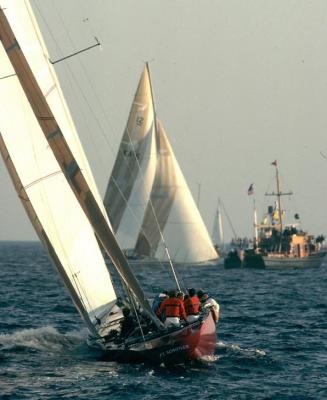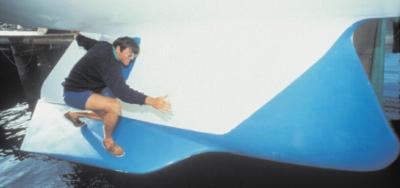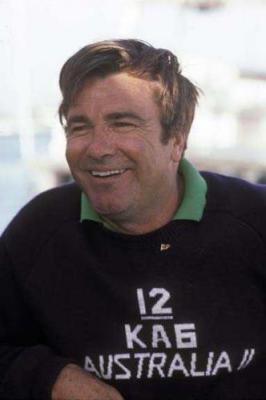The Test of Time Feb 20, 09:58
Interesting article a week or so back by Tim Lane in Melbourne's The Age newspaper. Recently an Australian radio station conducted a poll asking listeners to rank the top 25 sports moments in Australian history. Numero uno was the win by Australia II in the 1983 Cup.
The complete article is here, and we have excerpted a good chunk of it below. Good ink for the Cup and the most famous challenger of all time, to say nothing of a reminder to all of us about what an AC win can mean....
The America's Cup success touched the national psyche in a way that clearly
has stood the test of time. In spite of the impression of the America's Cup as a
rich men's plaything, regardless of the fate that befell Alan Bond, and in
defiance of the fact that for the masses this isn't a spectator sport, and that
until the final race of the 1983 contest there was no television coverage
anyway, the America's Cup win remains etched in our national
consciousness.
It's fair to say there's no great mystery as to why: it was a classic
victory for the little guy, and we were him. We knocked off the most powerful
nation on earth in a battle of technology, as well as of sporting skill, and we
were able to thumb our collective nose at what became a convenient embodiment of
American power, and thus arrogance, namely the New York Yacht Club. The reasons
for the event's enduring appeal are beyond argument.
What does remain open to debate, though, is just what it was that enabled
Australia to snap the US's 132-year winning streak. Was it, as Bertrand argued
passionately in his 1985 book Born to Win, the performance of his crew and
sail-cutting team, or was it, as the Americans prefer to view it, a contentious
breakthrough in 12-metre yacht design that won the day?
The Americans were obsessed with the Australian
challenger well before the showdown arrived. As the three potential US defenders
battled out their elimination trials, one American said: "We have boat trouble
and her name is Australia II." The NYYC challenged the legitimacy of Ben
Lexcen's winged keel and even sought to demonstrate that it was a Dutch
design.
Halsey Herreshoff, who was Dennis Conner's navigator on board the American
defender, Liberty, foreshadowed in the lead-up that if the keel design was
allowed to "continue to be rated without penalty," Australia II was likely to
win. It is salient to note that Herreshoff subsequently appears to have made a
different assessment. In reviewing the event, he said "the ballyhoo about that
(the keel) masked the significant facts that Australia II was the first boat to
go to minimum 12-metre length and displacement and that she had significantly
less wetted surface than any other Twelve; this latter fact won the
Cup!"
On the matter of ballyhoo, he is in agreement with Bertrand. The Australian
skipper claimed in his book that he used the mystery of the keel to unsettle the
Americans and that Conner "was vulnerable because he had fallen victim."
Bertrand insists while his boat was more manoeuvrable at the starts and in
tacking duels, in most conditions, it was no faster than Liberty.
Conner's view is reflected, presumably, in the preface of a 1987
reprint of his 1978 book, No Excuse to Lose. There, his collaborator John
Rousmaniere praises Conner for coming "within a few seconds of winning … against
a vastly superior boat."
Regardless, the 1983 Cup will go down in history, along with 1920 and 1934, as one of the very few great AC Matches.
Speaking of John Rousmaniere, a long-time friend and noted Cup historian, he has written a nice piece for the current (March 2006) issue of Sailing World magazine. Entitled "Who Designed Australia II?", hopefully the article will sooner or later end up on the mags website.
With all that has been done to liven up the proceedings for AC 32, and the close and intense competition to date, is 2007 shaping up to be another barn burner like '83?
We would also like to take this opportunity to congratulate the family and supporters of Australia II's design coordinator, the late Ben Lexcen (née Bob Miller), who has finally been elected to the AC Hall of Fame (for induction this coming October). There should have never been any question that Mr Lexcen was a crucial factor in A II's success and hence deserving of the HoF recognition; but that got lost in the on-going emotion over whether non-Aussies also participated in the design. Under today's AC rules, all that transpired in 1982-83 is a non-issue.
So it is good to see that both Australia II's win, and Ben Lexcen, have withstood the test of time; and heartening to know that the AC rules have been modernized in respect of designers, accommodating the march of time.
 Australia II winning race 7, and the 1983 Cup -- ending
Australia II winning race 7, and the 1983 Cup -- ending
NYYC's 132-year winning streak. Photo© Daniel Forster from
the Scuttlebutt website.
 Ben Lexcen on A II's keel in Newport, the day after winning the
Ben Lexcen on A II's keel in Newport, the day after winning the
1983 Cup. All summer the keel had been shrouded when A II was
in the boathoist at the dock. The paint job was to help disguise the
keel's radical shape from helicopter photograpers when A II was
sailing. Photo© Dan Nerney.
 Ben Lexcen, 1936-1988. Photo© Dan Nerney.
Ben Lexcen, 1936-1988. Photo© Dan Nerney.
Our thanks to another long-time (as opposed to old?) friend and NYYC member, Dan Nerney, whose two by now classic photos of "Benny" are used above, with his kind permission.
The complete article is here, and we have excerpted a good chunk of it below. Good ink for the Cup and the most famous challenger of all time, to say nothing of a reminder to all of us about what an AC win can mean....
The America's Cup success touched the national psyche in a way that clearly
has stood the test of time. In spite of the impression of the America's Cup as a
rich men's plaything, regardless of the fate that befell Alan Bond, and in
defiance of the fact that for the masses this isn't a spectator sport, and that
until the final race of the 1983 contest there was no television coverage
anyway, the America's Cup win remains etched in our national
consciousness.
It's fair to say there's no great mystery as to why: it was a classic
victory for the little guy, and we were him. We knocked off the most powerful
nation on earth in a battle of technology, as well as of sporting skill, and we
were able to thumb our collective nose at what became a convenient embodiment of
American power, and thus arrogance, namely the New York Yacht Club. The reasons
for the event's enduring appeal are beyond argument.
What does remain open to debate, though, is just what it was that enabled
Australia to snap the US's 132-year winning streak. Was it, as Bertrand argued
passionately in his 1985 book Born to Win, the performance of his crew and
sail-cutting team, or was it, as the Americans prefer to view it, a contentious
breakthrough in 12-metre yacht design that won the day?
The Americans were obsessed with the Australian
challenger well before the showdown arrived. As the three potential US defenders
battled out their elimination trials, one American said: "We have boat trouble
and her name is Australia II." The NYYC challenged the legitimacy of Ben
Lexcen's winged keel and even sought to demonstrate that it was a Dutch
design.
Halsey Herreshoff, who was Dennis Conner's navigator on board the American
defender, Liberty, foreshadowed in the lead-up that if the keel design was
allowed to "continue to be rated without penalty," Australia II was likely to
win. It is salient to note that Herreshoff subsequently appears to have made a
different assessment. In reviewing the event, he said "the ballyhoo about that
(the keel) masked the significant facts that Australia II was the first boat to
go to minimum 12-metre length and displacement and that she had significantly
less wetted surface than any other Twelve; this latter fact won the
Cup!"
On the matter of ballyhoo, he is in agreement with Bertrand. The Australian
skipper claimed in his book that he used the mystery of the keel to unsettle the
Americans and that Conner "was vulnerable because he had fallen victim."
Bertrand insists while his boat was more manoeuvrable at the starts and in
tacking duels, in most conditions, it was no faster than Liberty.
Conner's view is reflected, presumably, in the preface of a 1987
reprint of his 1978 book, No Excuse to Lose. There, his collaborator John
Rousmaniere praises Conner for coming "within a few seconds of winning … against
a vastly superior boat."
Regardless, the 1983 Cup will go down in history, along with 1920 and 1934, as one of the very few great AC Matches.
Speaking of John Rousmaniere, a long-time friend and noted Cup historian, he has written a nice piece for the current (March 2006) issue of Sailing World magazine. Entitled "Who Designed Australia II?", hopefully the article will sooner or later end up on the mags website.
With all that has been done to liven up the proceedings for AC 32, and the close and intense competition to date, is 2007 shaping up to be another barn burner like '83?
We would also like to take this opportunity to congratulate the family and supporters of Australia II's design coordinator, the late Ben Lexcen (née Bob Miller), who has finally been elected to the AC Hall of Fame (for induction this coming October). There should have never been any question that Mr Lexcen was a crucial factor in A II's success and hence deserving of the HoF recognition; but that got lost in the on-going emotion over whether non-Aussies also participated in the design. Under today's AC rules, all that transpired in 1982-83 is a non-issue.
So it is good to see that both Australia II's win, and Ben Lexcen, have withstood the test of time; and heartening to know that the AC rules have been modernized in respect of designers, accommodating the march of time.
 Australia II winning race 7, and the 1983 Cup -- ending
Australia II winning race 7, and the 1983 Cup -- endingNYYC's 132-year winning streak. Photo© Daniel Forster from
the Scuttlebutt website.
 Ben Lexcen on A II's keel in Newport, the day after winning the
Ben Lexcen on A II's keel in Newport, the day after winning the1983 Cup. All summer the keel had been shrouded when A II was
in the boathoist at the dock. The paint job was to help disguise the
keel's radical shape from helicopter photograpers when A II was
sailing. Photo© Dan Nerney.
 Ben Lexcen, 1936-1988. Photo© Dan Nerney.
Ben Lexcen, 1936-1988. Photo© Dan Nerney.Our thanks to another long-time (as opposed to old?) friend and NYYC member, Dan Nerney, whose two by now classic photos of "Benny" are used above, with his kind permission.
History | by TFE